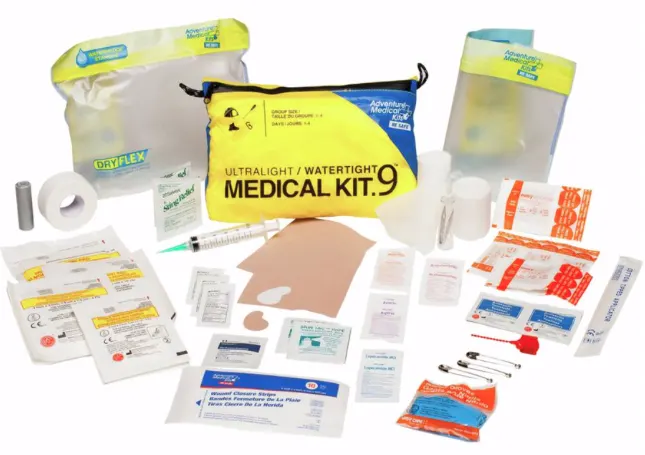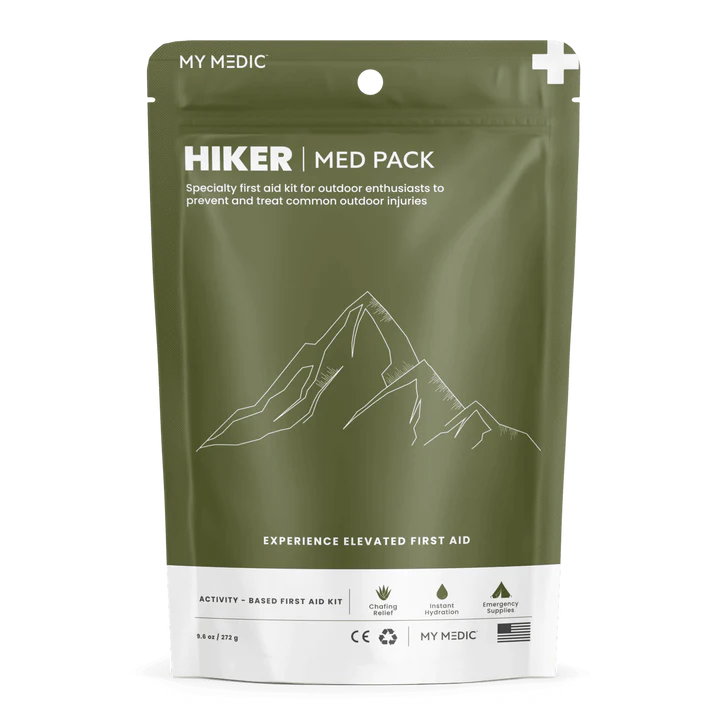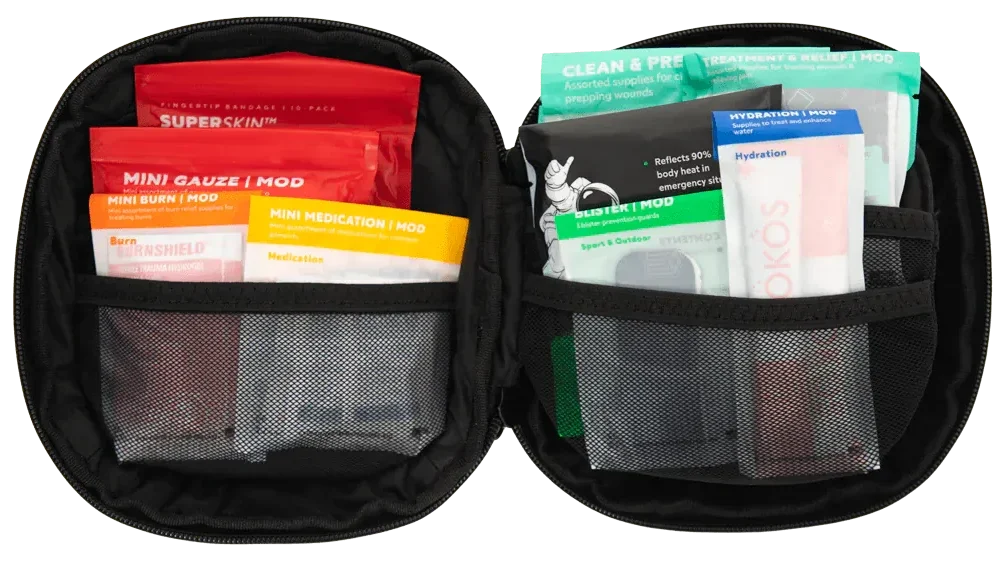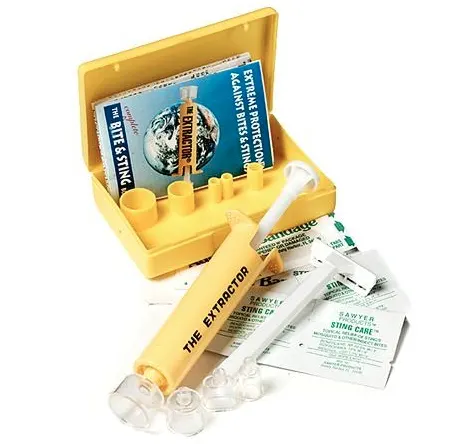
Maybe you think of first aid kits as the little plastic box that lives under your bathroom sink. Or the zippered pouch in the trunk of your car that hasn’t been restocked in ages. But did you know that a first aid kit is one of the 10 essentials you should always keep in your backpack whether you’re headed out on a short day hike or week-long excursion? Well, it is. ‘Cause you never know when you’re gonna need to treat a blister or bee sting, or worse, a sprained ankle or nasty gash. But what should be in a wilderness first aid kit? Here’s a list if you want to build one yourself (and a few solid pre-packed kits) based on your specific adventure.

What Should be in a Wilderness First Aid Kit: Day Hikes
Day hikes (trips ranging from 30 minutes to 13 hours where you don’t spend the night outdoors) may require a different set of first aid provisions than many longer overnight backpacking trips. Or at least slightly fewer. Especially if you’ll have quick access to roads or trailheads where you can get help easily if you need it. The biggest difference in the day hike kit list being that you don’t usually need to account for eventualities where you’ll likely be stuck in the wilderness for days longer than you planned to. That said, even if you’re going on an easy, short hike on a well-marked trail, you should always come prepared with a wilderness first aid kit. Here’s what to stuff inside on day hikes:
- Adhesive bandages in multiple shapes and sizes
- Elastic bandage
- Gauze pads and a roll
- Bite and sting relief ointment
- Moleskin or other blister treatment
- Antibiotic ointment
- Ibuprofen, acetaminophen
- Antihistamines
- Nitrile gloves
- Antiseptic wipes
- Tweezers
- Duct Tape (fixes everything!)
- CPR mask
- Scissors
Some of this may seem like overkill, but we’ve had to patch a bloody gash, cut gauze and treat blisters more often than we’d like to admit, even on 3-mile hikes close to home.

What Should be in a Wilderness First Aid Kit: Backpacking & Trekking
Overnight trips, on the other hand, whether they last one night or a dozen, require that you pack a few more items in your wilderness first aid kit. Mostly because you’ll likely be farther from medical help and care, so you’ll need to be self-sufficient and tackle more injuries on your own if they arise. Remember that the more people in your group and the longer your trip is, the more supplies should be in your kit. As in, you should bring a larger quantity of each item. Here’s what to bring on longer excursions:
- Adhesive bandages in multiple shapes and sizes
- Elastic bandage
- Gauze
- Bite and sting relief ointment
- Moleskin or other blister treatment
- Antibiotic ointment
- Ibuprofen, acetaminophen
- Antihistamines
- Nitrile gloves
- CPR mask
- Cotton swabs
- Duct Tape (fixes everything!)
- Antiseptic wipes
- Tweezers
- Wound irrigation syringe
- Medical tape
- Scissors
- Povidone-iodine (for preventing wound infection)
- Diamode (for treating diarrhea)
- Safety pins
- Quick clot agent

What Not to Put in a Wilderness First Aid Kit: Unnecessary Items
As many things as you should pack in your wilderness first aid kit, there are certainly a few you can leave at home. Manufacturers sell you on ease and preparedness, but even outdoor professionals admit these items are rarely necessary. Here are the things that you can leave at home (or on outdoor store shelves) to save on pack space and weight:
- Snakebite kit/Venom extractor (research shows these are essentially useless)
- Backcountry splint or tourniquet (these can be easily improvised with found materials and can be dangerous in non-emergency situations)
- Sling/V-shaped bandage (a T-shirt or bandana will often work just fine, but this is definitely a thing you can pack if you’re typically a minimalist hiker)
What Else to Carry with a Wilderness First Aid Kit: Additional Items
There are plenty of additional items that aren’t directly related to first aid but can still benefit overall health and well being (many are in the widely-respected list of 10 hiking essentials). So in addition to your wilderness first aid kit, bring this stuff along, too:
- A whistle (to call for help)
- Water purification tablets
- Sunscreen
- A Multitool or a knife
- Paracord
- Space blanket (in case you get caught in unexpectedly frigid weather)
- Hydration/electrolyte tablets or mix (especially in summer when losing moisture through sweat is an issue)
- A first aid guide

Where to Find Wilderness First Aid Kits
Time to quit risking it and buy a first aid kit? Or maybe restock an old kit (medications do expire, ya know)? There are plenty of options out there. For day hikes and shorter backpacking trips, we like the Adventure Medical .9 First Aid Kit because it’s small and light and has everything we need, but the MyMedic MedPacks Hiker Medic is a well-rounded kit, too (and comes with colorful bandages for the child in all of us). Keep in mind that with smaller kits you may have to augment with individual items like a CPR mask or gloves.
For longer or wilderness treks, check out the Hart Outdoors Multi Day Kit. It may weigh a little more, but you’re practically guaranteed to have everything you need at your fingertips should, as they say, the excrement hit the fan. So gear up and get out there. And don’t be afraid of blisters, lacerations and broken bones; you probably won’t suffer from any of them (but if you do, you’ll know you’re prepared).
Wander on!
